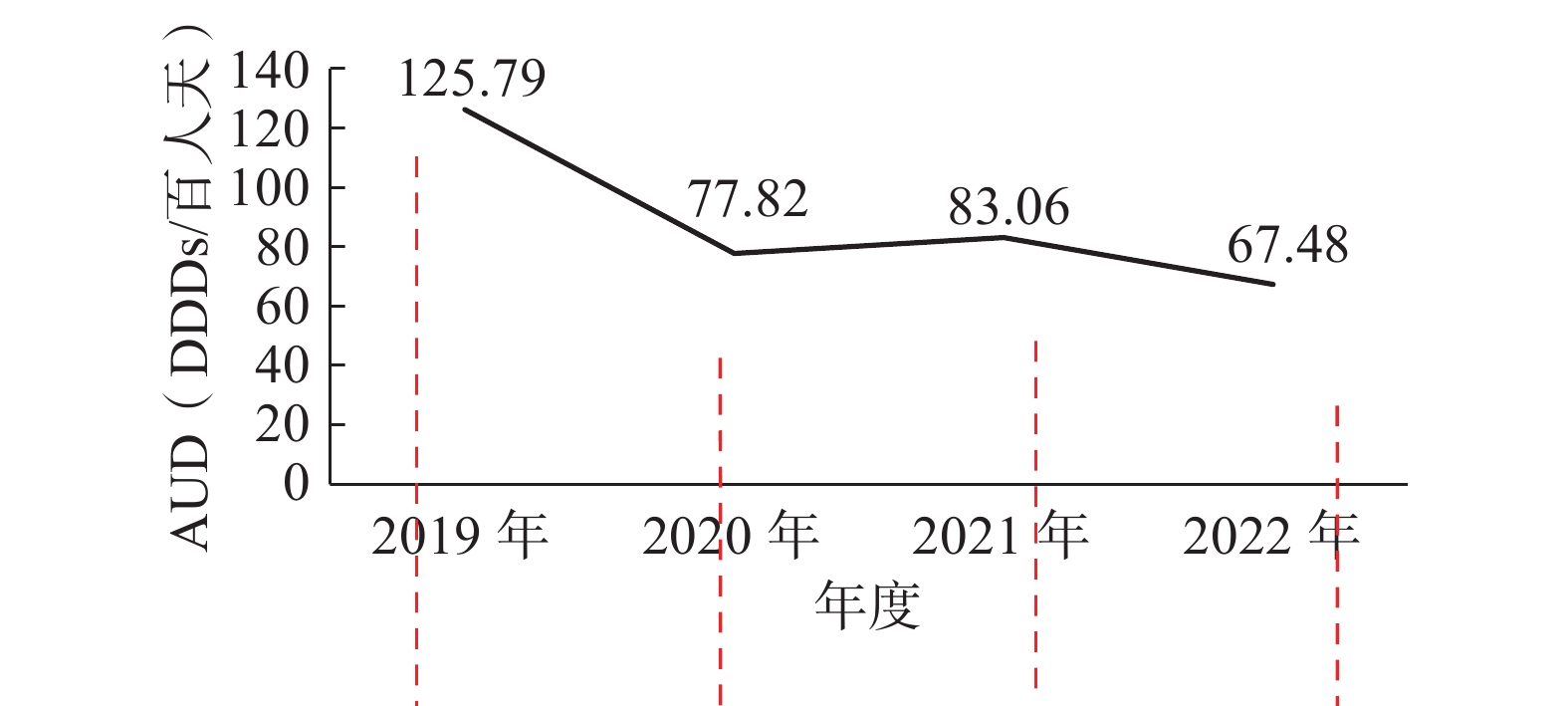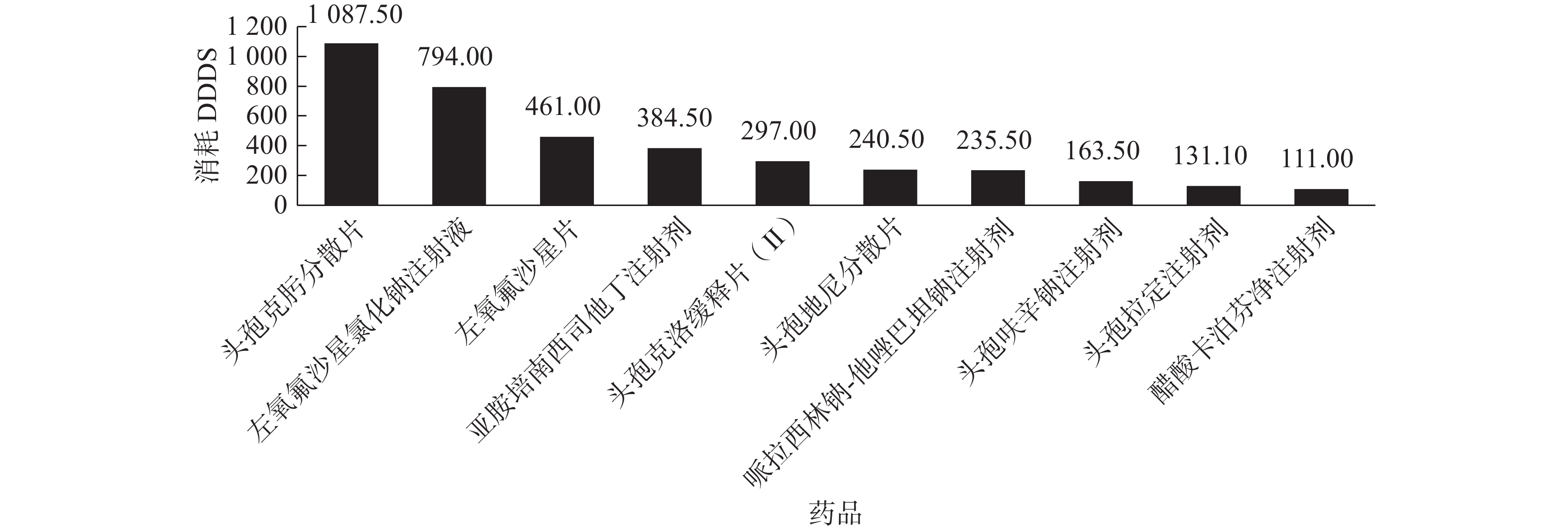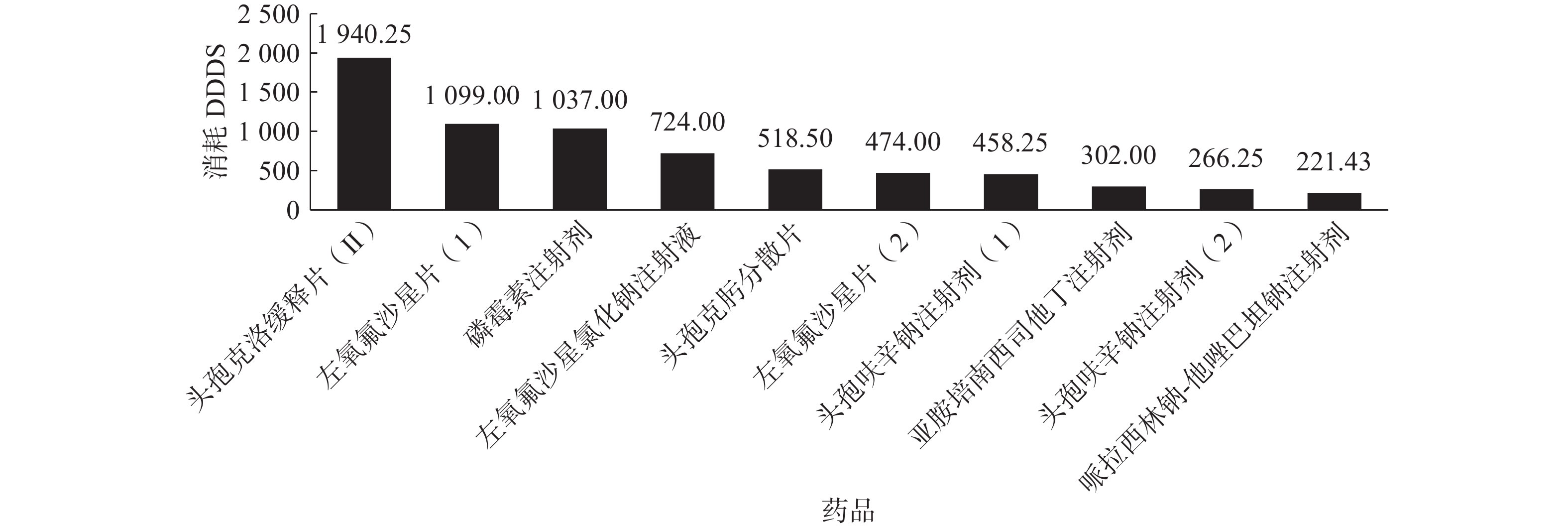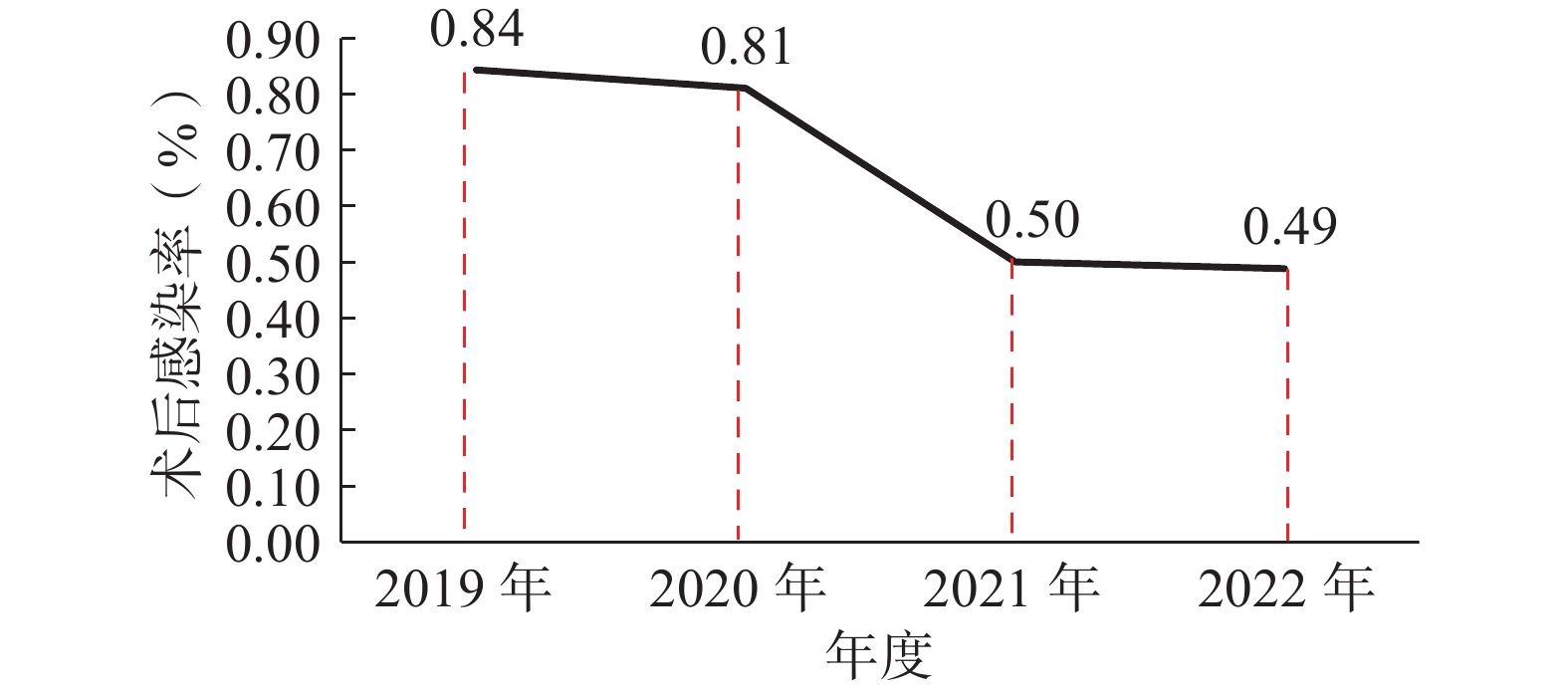-
尿石症的微创碎石术包括体外冲击波碎石术(ESWL),经输尿管镜碎石术(URL)和经皮肾镜取石术(PCNL)[1-3]。尿路感染是以上碎石术的最常见并发症,细菌或内毒素进入血流都可能导致败血症,这可能是致命的并发症[3-5]。近年来国内外有不少关于尿石症微创碎石术围手术期抗菌药物使用的指南共识和高质量研究结果发表,为围手术期抗菌药物使用提供了依据。但在泌尿外科碎石术临床实际工作中,仍存在多种不合理用药情况,如预防用药级别过高、联合用药不适宜,用药疗程过长等问题。为了遏制泌尿外科碎石术预防使用抗菌药物不合理使用现象的蔓延,在医院医务处牵头下,药剂科临床药师自2019年起协助泌尿外科管理碎石术预防使用的抗菌药物,并提供技术支持,经过4年的合理管控,产生了良好的效果。
-
优化目录和加大限量力度,先后将11个品规每月消耗金额上限分次逐步下调至12.5%;剔除异常增长品种;将8个与“三网”推荐目录相符性欠佳的品规,从本院供应目录剔除;要求科室主任组织科室人员学习抗菌药物合理使用,并签订抗菌药物使用强度逐步降低的目标责任状,每年结合医院整体的目标,根据各临床科室不同专业特点和上一年指标完成情况,个性化定制下一年的目标。
-
每月开展抗菌药物使用强度点评,每季度开展特殊使用级抗菌药物专项点评和异常增长抗菌药物的专项点评。临床药师进行逐个点评,分析科室用药特点,与临床科室沟通,分析不合理原因,最终形成报告。点评结果以合理用药点评简报和长海药学服务(药讯)的方式通过大周会、企业微信等多渠道向全院进行通报,并对部分不合理用药问题较为突出的科室和医生要求重新学习《抗菌药物临床应用指导原则( 2015 年版)》等指南规范。
-
强化事前审方规则基础维护工作,发动全科药师利用业余时间积极审核和拟定评价规则,调整、新增处方前置审核规则
3874 条,其中新增以抗菌药物为重点的规则195条,其中拦截性规则28条,提醒性规则167条。重点有计划地审核和设“用药适应证”及“禁忌证”这些非常重要但原有系统因技术困难却缺乏的规则,力求从合理用药系统的基础维护方面步步推进、打牢基础,不断完善信息化手段,在合理用药管理中发挥应有的作用。 -
抗菌药物科学化管理得到全院各科室的重视,临床科室主动要求临床药师开展抗菌药物合理应用系列专题讲座,如《泌尿相关的抗菌药物使用及强度分享》《药敏报告的解读》《头孢菌素过敏性休克不良反应的案例介绍》等。了解科室抗菌药物使用的盲点、弱点和担忧点,根据科室具体情况分析如何合理使用抗菌药物。
临床药师在全院多科室轮转,包括急诊科、呼吸科、肝胆胰腺外科、泌尿外科、脑外科、胃肠外科、肾内科、微生物室等,和医生一起解决临床实际问题。临床药师多次参加抗感染会诊,对特殊病理生理状态下患者抗菌药物选择,抗菌药物剂量、疗程把握以及不良反应判断和处理提供参考意见。
在《泌尿相关的抗菌药物使用及强度分享》中临床药师除向泌尿外科医生讲解抗菌药物使用强度的定义、临床意义、计算方法、影响因素等基础内容外,着重讲解了泌尿外科碎石术预防使用抗菌药物的合理选择。后续临床药师与泌尿外科医生持续保持沟通,及时解决泌尿外科提出的碎石术预防使用抗菌药物相关问题。
-
⑴临床药师开展临床路径用药规则审核完善工作,针对全院360余个临床路径涉及的抗菌药物品种选择、给药剂量和用药疗程等一系列问题进行评价和反馈。涉及泌尿系统碎石术预防用药的临床路径有3个,分别为经皮肾镜碎石术、输尿管结石行输尿管镜碎石术、肾结石行输尿管软镜碎石术治疗。
⑵抗菌药物临时采购审批启用企业微信,流程中增加临床药师审核。
⑶特殊使用级抗菌药物申请需通过企业微信进行审批,进一步提高院内信息化手段在合理用药管理中的作用。
-
临床科室积极配合整改。通过完善院前检查和抗菌药物治疗,降低HALF分类方法[6]中高危组患者的尿路细菌负荷后,再收入院开展碎石术。通过合理预防使用抗菌药物,有效的降低了抗菌药物使用率和使用强度。
-
从大数据中心的医院运营管理系统(Rbase系统)提取2019−2022年泌尿外科抗菌药物相关指标数据,主要分析泌尿外科住院抗菌药物使用率、微生物送检率、抗菌药物使用强度(AUD),以及泌尿系统碎石术预防使用抗菌药物消耗量排名和泌尿外科碳青霉烯类抗菌药物消耗量排名在管控前后的变化。数据采用 Microsoft Excel 16 统计和分析。
-
与2019年相比,2022年泌尿外科抗菌药物多项指标趋于达标,各项指标目标值来自于《关于进一步加强抗菌药物临床应用管理工作的通知》(国卫办医发〔2015〕42号)。住院抗菌药物使用率由94.27%下降为77.47%,但未达标(见表1);自2019年住院抗菌药物使用强度呈逐年下降趋势,如图1所示;由125.79 DDDs/百人天下降为67.48 DDDs/百人天,但未达标(见表1);微生物送检率(限制类)由2019年的42.71%上升至60.91%,符合要求(见表1)。
表 1 2019年和2022年泌尿外科抗菌药物指标详情
项目 2019 2022 目标值 住院抗菌药物使用率(%) 94.27 77.47 60 住院抗菌药物使用强度(DDDs/百人天) 125.79 67.48 40 微生物送检率(%) 39 52.74 30 微生物送检率(特殊类)(%) 91.69 93.66 80 微生物送检率(限制类)(%) 42.71 60.91 50 注:微生物送检率指接受抗菌药物治疗的住院患者微生物送检率;微生物送检率(特殊类)指接受特殊使用级抗菌药物治疗的住院患者微生物送检率;微生物送检率(限制类)指接受限制使用级抗菌药物治疗的住院患者微生物送检率。 -
2019年泌尿系统碎石术预防使用抗菌药物消耗DDDs排名第一位的是头孢克肟分散片(
1087.50 DDDs),左氧氟沙星氯化钠注射液和亚胺培南西司他丁注射剂分别排名第三和第四,如图2所示。2022年泌尿系统碎石术预防使用抗菌药物消耗DDDs排名第一位的是头孢克洛缓释片(Ⅱ)(1940.25 DDDs),左氧氟沙星氯化钠注射液和亚胺培南西司他丁注射剂分别排名第四和第八,如图3所示。与2019年相比,2022年消耗DDDs排名第一位的抗菌药物由第三代头孢菌素变为第二代头孢菌素;左氧氟沙星氯化钠注射液排名下降一个位次,亚胺培南西司他丁注射剂排名下降明显,下降四个位次。 -
2019年全院碳青霉烯类抗菌药物消耗DDDs排名第一位科室是血液内科(
3064.78 DDDs),泌尿外科排名第八,碳青霉烯类抗菌药物消耗696.5 DDDs,如图4所示;2022年全院碳青霉烯类抗菌药物消耗DDDs排名第一位科室是急诊科,泌尿外科排名第十二,碳青霉烯类抗菌药物消耗641.82 DDDs,如图5所示。与2019年相比,碳青霉烯类抗菌药物消耗DDDs科室排名,泌尿外科下降四个位次。 -
自2019年泌尿系统碎石术后感染的发生率呈逐年下降趋势,由2019年0.84%下降为0.49%,如图6所示。
-
目前国内外有越来越多的关于泌尿系统碎石术预防使用抗菌药物的指南共识,为尿路结石患者围手术期感染控制提供了很好的指导。但由于影响泌尿系统碎石术感染的因素较多[7-8],尿路感染的评价方法不同于常规感染,预防感染控制不佳会导致重症感染等原因,在临床实际工作中泌尿系统碎石术预防使用抗菌药物存在多种不合理问题,如选药品种起点较高、预防用药时间长和联合用药不适宜。其中较为突出的问题是选药品种起点较高,经点评发现有的病历甚至选用碳青霉烯类作为泌尿系统碎石术预防感染的抗菌药物,这一点在邵燕等[9]的报道中也有发现。关于泌尿系统碎石术预防感染的抗菌药物选择,国内一般推荐第一、二代头孢菌素或氟喹诺酮类[10], 国际上推荐的品种较多,有氟喹诺酮类,一、二代头孢菌素,氨基糖苷类+甲硝唑或克林霉素,阿莫西林/克拉维酸,氨苄西林/舒巴坦等[11-12]。碳青霉烯类往往会选作为尿路感染的治疗性抗菌药物[13-15] 。
针对泌尿外科抗菌药物使用强度过高, 泌尿系统碎石术预防使用碳青霉烯类情况较为普遍的问题,对该科抗菌药物的管控除了开展抗菌药物科学化管理,加强全院抗菌药物点评和通报,增补完善抗菌药物处方前置审核规则,临床药师深入临床进行培训与会诊以及通过信息化手段加强合理用药工作创新的全院举措外。针对泌尿系统碎石术抗菌药物预防使用,临床药师开展了《泌尿相关的抗菌药物使用及强度分享》专题讲座,对经皮肾镜碎石术、输尿管结石行输尿管镜碎石术、肾结石行输尿管软镜碎石术治疗临床路径涉及的抗菌药物进行评价和反馈。另科室积极配合整改,在入院之前通过降低尿路结石手术患者高危组尿路的细菌负荷后,再收入院开展碎石术,降低了围手术期感染的风险,避免了围手术期预防使用高级别的抗菌药物。
通过以上由面及点的科学化管理,2022年泌尿外科抗菌药物使用强度出现大幅降低,趋于目标值。泌尿系统碎石术预防使用碳青霉烯类的现象明显减少,主要体现在该科室碎石术预防使用抗菌药物消耗DDDs排名中亚胺培南西司他丁注射剂排名明显下降,以及全院碳青霉烯类抗菌药物消耗DDDs排名中泌尿外科名次明显下降。该科室使用碳青霉烯类抗菌药物不合理现象明显减少,与此同时泌尿系统碎石术后感染的发生率呈逐年下降趋势,说明以上院科两级的管控措施效果显著。
鉴于泌尿外科抗菌药物使用强度距离目标值还有一定差距,下一步除继续加强全院抗菌药物科学化管理外,临床药师需协助临床医生根据HALF分类方法,将拟进行碎石术患者进行分组后,再进行有针对性的术前准备和个体化的抗菌药物使用。最后希望通过全面的抗菌药物管控和精细化、个体化的用药指导,泌尿外科的抗菌药物使用强度达到目标值,泌尿系统碎石术抗菌药物预防使用更加合理。
Reasonable management and control practice of prophylactic use of antibiotics for urinary system lithotripsy
-
摘要:
目的 合理管控泌尿系统碎石术抗菌药物预防使用,并分析管控措施的成效。 方法 通过开展抗菌药物科学化管理,加强抗菌药物专项点评和合理用药信息通报,增补完善抗菌药物处方前置审核规则,临床药师深入临床进行培训与会诊,加强合理用药工作创新以及泌尿外科针对碎石术预防使用抗菌药物积极整改的多项措施,分析2019−2022年泌尿外科抗菌药物相关指标数据的变化。 结果 积极的合理管控后,泌尿外科抗菌药物使用强度逐年下降;住院患者抗菌药物使用率由2019年的94.27%下降为2022年的77.47%;各项微生物送检率于2022年都达标;泌尿系统碎石术预防使用抗菌药物消耗DDDs品种排名中亚胺培南西司他丁注射剂由2019年的第四位下降为2022年的第八位;碳青霉烯类抗菌药物消耗DDDs全院科室排名中泌尿外科由2019年的第八位下降为2022年的第十二位;与此同时泌尿系统碎石术后感染的发生率呈逐年下降趋势,由2019年的0.84%下降为2022年的0.49%。 结论 积极的管控措施可促进泌尿系统碎石术抗菌药物预防使用趋于合理。 Abstract:Objective To analyze the effectiveness of reasonable control measures for prophylactic use of antibiotics for urinary system lithotripsy. Methods By antimicrobial stewardship, strengthening special comments on antibiotics and information notification on rational use of antibiotics, adding and improving the pre-review rules for antibiotics prescriptions, conducting in-depth clinical training and consultation by clinical pharmacists, strengthening innovation in rational use of drugs, and taking various measures to actively improve rational use of prophylactic antibiotics of lithotripsy in urology department, the changes of indexes related to antibiotics in urology department from 2019 to 2022 were analyzed. Results After active and reasonable control, Antibiotics Use Density in urology department decreased year by year. The utilization rate of antibiotics in inpatients decreased from 94.27% in 2019 to 77.47% in 2022. Various rate of microbial inspection reached the standard in 2022; The imipenem and cilastatin sodium for injection ranking of prophylactic use of antibiotics consumption DDDs for urinary system lithotripsy decreased from the 4th place in 2019 to the 8th place in 2022. The ranking of the urology department on carbapenem consumption DDDs in the whole hospital decreased from the 8th place in 2019 to the 12th place in 2022. At the same time, the incidence of urinary tract lithotripsy postoperative infection showed a decreasing trend year by year, from 0.84% in 2019 to 0.49% in 2022. Conclusion Positive control measures can promote the rational use of prophylactic antibiotics for urinary system lithotripsy. -
尿石症的微创碎石术包括体外冲击波碎石术(ESWL),经输尿管镜碎石术(URL)和经皮肾镜取石术(PCNL)[1-3]。尿路感染是以上碎石术的最常见并发症,细菌或内毒素进入血流都可能导致败血症,这可能是致命的并发症[3-5]。近年来国内外有不少关于尿石症微创碎石术围手术期抗菌药物使用的指南共识和高质量研究结果发表,为围手术期抗菌药物使用提供了依据。但在泌尿外科碎石术临床实际工作中,仍存在多种不合理用药情况,如预防用药级别过高、联合用药不适宜,用药疗程过长等问题。为了遏制泌尿外科碎石术预防使用抗菌药物不合理使用现象的蔓延,在医院医务处牵头下,药剂科临床药师自2019年起协助泌尿外科管理碎石术预防使用的抗菌药物,并提供技术支持,经过4年的合理管控,产生了良好的效果。
1. 管控方法
1.1 抗菌药物科学化管理
优化目录和加大限量力度,先后将11个品规每月消耗金额上限分次逐步下调至12.5%;剔除异常增长品种;将8个与“三网”推荐目录相符性欠佳的品规,从本院供应目录剔除;要求科室主任组织科室人员学习抗菌药物合理使用,并签订抗菌药物使用强度逐步降低的目标责任状,每年结合医院整体的目标,根据各临床科室不同专业特点和上一年指标完成情况,个性化定制下一年的目标。
1.2 加强抗菌药物专项点评和合理用药信息通报
每月开展抗菌药物使用强度点评,每季度开展特殊使用级抗菌药物专项点评和异常增长抗菌药物的专项点评。临床药师进行逐个点评,分析科室用药特点,与临床科室沟通,分析不合理原因,最终形成报告。点评结果以合理用药点评简报和长海药学服务(药讯)的方式通过大周会、企业微信等多渠道向全院进行通报,并对部分不合理用药问题较为突出的科室和医生要求重新学习《抗菌药物临床应用指导原则( 2015 年版)》等指南规范。
1.3 增补完善抗菌药物处方前置审核规则
强化事前审方规则基础维护工作,发动全科药师利用业余时间积极审核和拟定评价规则,调整、新增处方前置审核规则
3874 条,其中新增以抗菌药物为重点的规则195条,其中拦截性规则28条,提醒性规则167条。重点有计划地审核和设“用药适应证”及“禁忌证”这些非常重要但原有系统因技术困难却缺乏的规则,力求从合理用药系统的基础维护方面步步推进、打牢基础,不断完善信息化手段,在合理用药管理中发挥应有的作用。1.4 临床药师深入临床进行培训与会诊
抗菌药物科学化管理得到全院各科室的重视,临床科室主动要求临床药师开展抗菌药物合理应用系列专题讲座,如《泌尿相关的抗菌药物使用及强度分享》《药敏报告的解读》《头孢菌素过敏性休克不良反应的案例介绍》等。了解科室抗菌药物使用的盲点、弱点和担忧点,根据科室具体情况分析如何合理使用抗菌药物。
临床药师在全院多科室轮转,包括急诊科、呼吸科、肝胆胰腺外科、泌尿外科、脑外科、胃肠外科、肾内科、微生物室等,和医生一起解决临床实际问题。临床药师多次参加抗感染会诊,对特殊病理生理状态下患者抗菌药物选择,抗菌药物剂量、疗程把握以及不良反应判断和处理提供参考意见。
在《泌尿相关的抗菌药物使用及强度分享》中临床药师除向泌尿外科医生讲解抗菌药物使用强度的定义、临床意义、计算方法、影响因素等基础内容外,着重讲解了泌尿外科碎石术预防使用抗菌药物的合理选择。后续临床药师与泌尿外科医生持续保持沟通,及时解决泌尿外科提出的碎石术预防使用抗菌药物相关问题。
1.5 加强合理用药工作创新
⑴临床药师开展临床路径用药规则审核完善工作,针对全院360余个临床路径涉及的抗菌药物品种选择、给药剂量和用药疗程等一系列问题进行评价和反馈。涉及泌尿系统碎石术预防用药的临床路径有3个,分别为经皮肾镜碎石术、输尿管结石行输尿管镜碎石术、肾结石行输尿管软镜碎石术治疗。
⑵抗菌药物临时采购审批启用企业微信,流程中增加临床药师审核。
⑶特殊使用级抗菌药物申请需通过企业微信进行审批,进一步提高院内信息化手段在合理用药管理中的作用。
1.6 泌尿外科针对碎石术预防使用抗菌药物积极整改
临床科室积极配合整改。通过完善院前检查和抗菌药物治疗,降低HALF分类方法[6]中高危组患者的尿路细菌负荷后,再收入院开展碎石术。通过合理预防使用抗菌药物,有效的降低了抗菌药物使用率和使用强度。
2. 数据统计与分析
从大数据中心的医院运营管理系统(Rbase系统)提取2019−2022年泌尿外科抗菌药物相关指标数据,主要分析泌尿外科住院抗菌药物使用率、微生物送检率、抗菌药物使用强度(AUD),以及泌尿系统碎石术预防使用抗菌药物消耗量排名和泌尿外科碳青霉烯类抗菌药物消耗量排名在管控前后的变化。数据采用 Microsoft Excel 16 统计和分析。
3. 结果
3.1 泌尿外科抗菌药物指标变化
与2019年相比,2022年泌尿外科抗菌药物多项指标趋于达标,各项指标目标值来自于《关于进一步加强抗菌药物临床应用管理工作的通知》(国卫办医发〔2015〕42号)。住院抗菌药物使用率由94.27%下降为77.47%,但未达标(见表1);自2019年住院抗菌药物使用强度呈逐年下降趋势,如图1所示;由125.79 DDDs/百人天下降为67.48 DDDs/百人天,但未达标(见表1);微生物送检率(限制类)由2019年的42.71%上升至60.91%,符合要求(见表1)。
表 1 2019年和2022年泌尿外科抗菌药物指标详情项目 2019 2022 目标值 住院抗菌药物使用率(%) 94.27 77.47 60 住院抗菌药物使用强度(DDDs/百人天) 125.79 67.48 40 微生物送检率(%) 39 52.74 30 微生物送检率(特殊类)(%) 91.69 93.66 80 微生物送检率(限制类)(%) 42.71 60.91 50 注:微生物送检率指接受抗菌药物治疗的住院患者微生物送检率;微生物送检率(特殊类)指接受特殊使用级抗菌药物治疗的住院患者微生物送检率;微生物送检率(限制类)指接受限制使用级抗菌药物治疗的住院患者微生物送检率。 3.2 泌尿系统碎石术预防使用抗菌药物消耗DDDs排名前10品种
2019年泌尿系统碎石术预防使用抗菌药物消耗DDDs排名第一位的是头孢克肟分散片(
1087.50 DDDs),左氧氟沙星氯化钠注射液和亚胺培南西司他丁注射剂分别排名第三和第四,如图2所示。2022年泌尿系统碎石术预防使用抗菌药物消耗DDDs排名第一位的是头孢克洛缓释片(Ⅱ)(1940.25 DDDs),左氧氟沙星氯化钠注射液和亚胺培南西司他丁注射剂分别排名第四和第八,如图3所示。与2019年相比,2022年消耗DDDs排名第一位的抗菌药物由第三代头孢菌素变为第二代头孢菌素;左氧氟沙星氯化钠注射液排名下降一个位次,亚胺培南西司他丁注射剂排名下降明显,下降四个位次。3.3 碳青霉烯类抗菌药物消耗DDDs排名前10科室
2019年全院碳青霉烯类抗菌药物消耗DDDs排名第一位科室是血液内科(
3064.78 DDDs),泌尿外科排名第八,碳青霉烯类抗菌药物消耗696.5 DDDs,如图4所示;2022年全院碳青霉烯类抗菌药物消耗DDDs排名第一位科室是急诊科,泌尿外科排名第十二,碳青霉烯类抗菌药物消耗641.82 DDDs,如图5所示。与2019年相比,碳青霉烯类抗菌药物消耗DDDs科室排名,泌尿外科下降四个位次。3.4 泌尿系统碎石术后感染的发生率
自2019年泌尿系统碎石术后感染的发生率呈逐年下降趋势,由2019年0.84%下降为0.49%,如图6所示。
4. 讨论
目前国内外有越来越多的关于泌尿系统碎石术预防使用抗菌药物的指南共识,为尿路结石患者围手术期感染控制提供了很好的指导。但由于影响泌尿系统碎石术感染的因素较多[7-8],尿路感染的评价方法不同于常规感染,预防感染控制不佳会导致重症感染等原因,在临床实际工作中泌尿系统碎石术预防使用抗菌药物存在多种不合理问题,如选药品种起点较高、预防用药时间长和联合用药不适宜。其中较为突出的问题是选药品种起点较高,经点评发现有的病历甚至选用碳青霉烯类作为泌尿系统碎石术预防感染的抗菌药物,这一点在邵燕等[9]的报道中也有发现。关于泌尿系统碎石术预防感染的抗菌药物选择,国内一般推荐第一、二代头孢菌素或氟喹诺酮类[10], 国际上推荐的品种较多,有氟喹诺酮类,一、二代头孢菌素,氨基糖苷类+甲硝唑或克林霉素,阿莫西林/克拉维酸,氨苄西林/舒巴坦等[11-12]。碳青霉烯类往往会选作为尿路感染的治疗性抗菌药物[13-15] 。
针对泌尿外科抗菌药物使用强度过高, 泌尿系统碎石术预防使用碳青霉烯类情况较为普遍的问题,对该科抗菌药物的管控除了开展抗菌药物科学化管理,加强全院抗菌药物点评和通报,增补完善抗菌药物处方前置审核规则,临床药师深入临床进行培训与会诊以及通过信息化手段加强合理用药工作创新的全院举措外。针对泌尿系统碎石术抗菌药物预防使用,临床药师开展了《泌尿相关的抗菌药物使用及强度分享》专题讲座,对经皮肾镜碎石术、输尿管结石行输尿管镜碎石术、肾结石行输尿管软镜碎石术治疗临床路径涉及的抗菌药物进行评价和反馈。另科室积极配合整改,在入院之前通过降低尿路结石手术患者高危组尿路的细菌负荷后,再收入院开展碎石术,降低了围手术期感染的风险,避免了围手术期预防使用高级别的抗菌药物。
通过以上由面及点的科学化管理,2022年泌尿外科抗菌药物使用强度出现大幅降低,趋于目标值。泌尿系统碎石术预防使用碳青霉烯类的现象明显减少,主要体现在该科室碎石术预防使用抗菌药物消耗DDDs排名中亚胺培南西司他丁注射剂排名明显下降,以及全院碳青霉烯类抗菌药物消耗DDDs排名中泌尿外科名次明显下降。该科室使用碳青霉烯类抗菌药物不合理现象明显减少,与此同时泌尿系统碎石术后感染的发生率呈逐年下降趋势,说明以上院科两级的管控措施效果显著。
鉴于泌尿外科抗菌药物使用强度距离目标值还有一定差距,下一步除继续加强全院抗菌药物科学化管理外,临床药师需协助临床医生根据HALF分类方法,将拟进行碎石术患者进行分组后,再进行有针对性的术前准备和个体化的抗菌药物使用。最后希望通过全面的抗菌药物管控和精细化、个体化的用药指导,泌尿外科的抗菌药物使用强度达到目标值,泌尿系统碎石术抗菌药物预防使用更加合理。
-
表 1 2019年和2022年泌尿外科抗菌药物指标详情
项目 2019 2022 目标值 住院抗菌药物使用率(%) 94.27 77.47 60 住院抗菌药物使用强度(DDDs/百人天) 125.79 67.48 40 微生物送检率(%) 39 52.74 30 微生物送检率(特殊类)(%) 91.69 93.66 80 微生物送检率(限制类)(%) 42.71 60.91 50 注:微生物送检率指接受抗菌药物治疗的住院患者微生物送检率;微生物送检率(特殊类)指接受特殊使用级抗菌药物治疗的住院患者微生物送检率;微生物送检率(限制类)指接受限制使用级抗菌药物治疗的住院患者微生物送检率。 -
[1] SKOLARIKOS A, JUNG H, NEISIUS A, et al. EAU Guidelines on urolithiasis [J]. European Association of Urology Guidelines 2023 edition, 2023: 1-120. https://d56bochluxqnz.cloudfront.net/documents/ full-guideline/ EAU-Guidelines-on-Urolithiasis-2023.pdf. [2] GERAGHTY R M, DAVIS N F, TZELVES L, et al. Best practice in interventional management of urolithiasis: an update from the European association of urology guidelines panel for urolithiasis 2022[J]. Eur Urol Focus, 2023, 9(1):199-208. doi: 10.1016/j.euf.2022.06.014 [3] 泌尿外科手术部位感染预防中国专家共识编写组. 泌尿外科手术部位感染预防中国专家共识(2019版)[J]. 中华泌尿外科杂志, 2019, 40(6):401-404. doi: 10.3760/cma.j.issn.1000-6702.2019.06.001 [4] 上尿路结石围手术期感染控制及抗菌药物应用专家意见编写组. 上尿路结石患者围手术期感染控制及抗菌药物应用专家意见(2023版)[J]. 中华泌尿外科杂志, 2023, 44(7):481-485. [5] BONKAT G, BARTOLETTI R, BRURUYÈRE F, et al. EAU Guidelines on Urological Infections[J]. European Association of Urology Guidelines 2023 edition, 2023: 1-84. [6] 乔庐东, 陈山, 马小军, 等. 上尿路结石患者围手术期抗菌药物应用的专家意见[J]. 中华泌尿外科杂志, 2017, 38(9):641-643. [7] CHEN D, JIANG C H, LIANG X F, et al. Early and rapid prediction of postoperative infections following percutaneous nephrolithotomy in patients with complex kidney stones[J]. BJU Int, 2019, 123(6):1041-1047. doi: 10.1111/bju.14484 [8] ZHOU G M, ZHOU Y, CHEN R, et al. The influencing factors of infectious complications after percutaneous nephrolithotomy: a systematic review and meta-analysis[J]. Urolithiasis, 2022, 51(1):17. doi: 10.1007/s00240-022-01376-5 [9] 邵燕, 刘群, 张东萍, 等. 我院特殊诊疗操作中预防性使用抗菌药物调查分析[J]. 中国药房, 2017, 28(26):3624-3627. doi: 10.6039/j.issn.1001-0408.2017.26.07 [10] 国卫办医发[2015]43号附件. 抗菌药物临床应用指导原则(2015年版). (2015-08-27)[2023-07-01]. https://www.gov.cn/xinwen/2015-08/27/content_2920799.htm. [11] WOLF J S Jr, BENNETT C J, DMOCHOWSKI R R, et al. Best practice policy statement on urologic surgery antimicrobial prophylaxis[J]. J Urol, 2008, 179(4):1379-1390. doi: 10.1016/j.juro.2008.01.068 [12] NABER KG. SCHAEFFER AJ. HEYNS CF, et a1. EAU-ICUD Urogenital infections [M]. First edition. The Netherlands: European Association of Urology-International Consultation on Urological Diseases, 2010: 645-710. [13] PORTSMOUTH S, VAN VEENHUYZEN D, ECHOLS R, et al. Cefiderocol versus imipenem-cilastatin for the treatment of complicated urinary tract infections caused by Gram-negative uropathogens: a phase 2, randomised, double-blind, non-inferiority trial[J]. Lancet Infect Dis, 2018, 18(12):1319-1328. doi: 10.1016/S1473-3099(18)30554-1 [14] TAN X M, PAN Q W, MO C G, et al. Carbapenems vs alternative antibiotics for the treatment of complicated urinary tract infection: a systematic review and network meta-analysis[J]. Medicine, 2020, 99(2):e18769. doi: 10.1097/MD.0000000000018769 [15] 黄茹润. 碳青霉烯类抗菌药物治疗复杂性尿路感染疗效和安全性的Meta分析[D]. 大理: 大理大学, 2021. -





 下载:
下载:






 下载:
下载:


